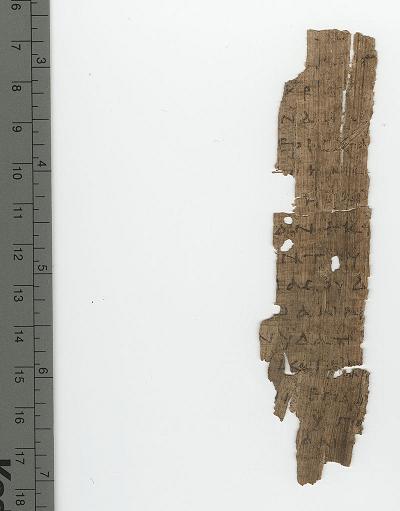| Change to Book/Chapter View |
|
|
|
Translation process is ongoing. For current status see details |
|
|

Papyrus 119 Discovered: Oxyrhynchus, Egypt Location: Oxford, England; Ashmolean Museum Contents: John 1:21-28, 38-44
John 1 21 They asked him, “What then? Are you Elijah?” He said, “I am not.” “Are you the prophet?” He answered, “No.” 22 They said therefore to him, “Who are you? Give us an answer to take back to those who sent us. What do you say about yourself?” 23 He said, “I am the voice of one crying in the wilderness, ‘Make straight the way of the Lord,’ as Isaiah the prophet said.” 24 The ones who had been sent were from the Pharisees. 25 They asked him, “Why then do you baptize, if you are not the Christ, nor Elijah, nor the prophet?” 26 John answered them, “I baptize in water, but among you stands one whom you don’t know. 27 He is the one who comes after me, who is preferred before me, whose sandal strap I’m not worthy to loosen.” 28 These things were done in Bethany beyond the Jordan, where John was baptizing. [..] 38 Jesus turned and saw them following, and said to them, “What are you looking for?” They said to him, “Rabbi” (which is to say, being interpreted, Teacher), “where are you staying?” 39 He said to them, “Come, and see.” They came and saw where he was staying, and they stayed with him that day. It was about the tenth hour. 40 One of the two who heard John and followed him was Andrew, Simon Peter’s brother. 41 He first found his own brother, Simon, and said to him, “We have found the Messiah!” (which is, being interpreted, Christ). 42 He brought him to Jesus. Jesus looked at him, and said to him, “You are Simon the son of Jonah. You shall be called Cephas” (which is by interpretation, Peter). 43 On the next day, he was determined to go out into Galilee, and he found Philip. Jesus said to him, “Follow me.” 44 Now Philip was from Bethsaida, of the city of Andrew and Peter.
|
How to read these pages: • The
translation to the left is based on the World English Bible. Words in regular
black font are words in the manuscript matching the Majority Text for that
passage. • Words
in italics cannot be seen in the manuscript, since the manuscript is
fragmentary. These words are supplied for readability by the World English
Bible translation. • Words
present in the manuscript but with some letters unreadable or missing are in blue
like this: blue. One Greek word often is
translated into multiple English words, and when this occurs, all the English
words are in blue. • Words
present in the manuscript but with spelling or trivial word order differences that do not affect the
meaning are in green like this: green. • If
the manuscript is different from the Majority Text, words in the Majority
Text that are missing from the text of the manuscript are marked through in red
like this: • If the manuscript is different from the Majority Text, words in the manuscript that are not in the Majority Text are underlined in red like this: new words.If the manuscript differs from the Majority Text yet matches another well-known text, this is noted in the footnotes.
|
